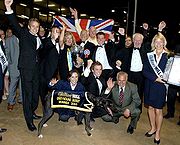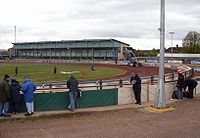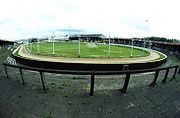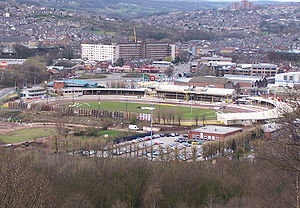
Greyhound racing in the United Kingdom
Encyclopedia

Greyhound racing
Greyhound racing is the sport of racing greyhounds. The dogs chase a lure on a track until they arrive at the finish line. The one that arrives first is the winner....
is a popular sport in Great Britain with attendances at around 3.2 million at over 5,750 meetings, across 26 stadia in 2007 alone. There are 26 stadia in Britain, it is a Parimutuel betting
Parimutuel betting
Parimutuel betting is a betting system in which all bets of a particular type are placed together in a pool; taxes and the "house-take" or "vig" is removed, and payoff odds are calculated by sharing the pool among all winning bets...
tote system with on-course and off-course betting available, with a turnover of £75,100,000.
History
Greyhound racing as it is seen today has evolved from a sport called coursingCoursing
Coursing is the pursuit of game or other animals by dogs—chiefly greyhounds and other sighthounds—catching their prey by speed, running by sight and not by scent. Coursing was a common hunting technique, practised by the nobility, the landed and wealthy, and commoners with sighthounds and lurchers...
, in which a dog runs after a live game animal – usually a rabbit
Rabbit
Rabbits are small mammals in the family Leporidae of the order Lagomorpha, found in several parts of the world...
or hare. The first official coursing meet was held in 1776 at Swaffham
Swaffham
Swaffham is a market town and civil parish in the English county of Norfolk. The town is situated east of King's Lynn and west of Norwich.The civil parish has an area of and in the 2001 census had a population of 6,935 in 3,130 households...
, Norfolk
Norfolk
Norfolk is a low-lying county in the East of England. It has borders with Lincolnshire to the west, Cambridgeshire to the west and southwest and Suffolk to the south. Its northern and eastern boundaries are the North Sea coast and to the north-west the county is bordered by The Wash. The county...
. The rules of the Swaffham Coursing Society specified that only two greyhounds were to course a single hare and that the hare was to be given a head start
Head start (positioning)
In positioning, a head start is a start in advance of the starting position of others in competition, or simply toward the finish line or desired outcome...
of 240 yards.
Coursing by proxy with an artificial lure was introduced at Hendon
Hendon
Hendon is a London suburb situated northwest of Charing Cross.-History:Hendon was historically a civil parish in the county of Middlesex. The manor is described in Domesday , but the name, 'Hendun' meaning 'at the highest hill', is earlier...
, on September 11, 1876. Six dogs raced over a 400-yard straight course, chasing an artificial hare riding. This was the first attempt of introducing mechanical racing to the UK, however it did not catch on at the time.
On July 24, 1926, in front of 1,700 spectators, the first greyhound race took place at Belle Vue Stadium
Belle Vue Stadium
Belle Vue Stadium is a greyhound racing track in Belle Vue, Manchester where the very first race around an oval track in Britain was held on 24 July 1926. It is also used for speedway as the home ground of Elite League team Belle Vue Aces since 1988 and since 1999 has British Stock Car Association...
where seven greyhounds raced round an oval circuit to catch an electric artificial hare. This marked the first ever modern greyhound race in Great Britain. Greyhound racing was brought to Britain from America by Charles Munn, an American businessman who obtained the overseas rights to the mechanical lure (hare). His business partners were Alfred Critchley and Francis Gentle and together they formed the Greyhound Racing Association
Greyhound Racing Association
The Greyhound Racing Association is a private company involved in the management of sports venues.It currently operates five sites:*Oxford Stadium*Wimbledon Stadium, London*Hall Green Stadium, Birmingham*Perry Barr Stadium, Birmingham...
(GRA) and raised £25,000 to build a racecourse at Belle Vue. They then hurried to open tracks in London at the White City
White City Stadium
White City Stadium was built in White City, London, for the 1908 Summer Olympics, often seen as the precursor to the modern seater stadium and noted for hosting the finish of the first modern distance marathon. It also hosted speedway and a match at the 1966 World Cup, before the stadium was...
and Haringey.
Racing
The sport of greyhound racing in Great Britain currently falls under two sectors: that licensed by the Greyhound Board of Great Britain (GBGB), and an unregulated sector known as 'independent racing' or 'flapping'.Licensed Racing
Licensed racing in Great Britain is regulated by the Greyhound Board of Great Britain (GBGB). All in the regulated sector are subject to the Greyhound Board of Great Britain (GBGB) Rules of Racing and the Directions of the Stewards, who set the standards for greyhound welfare and racing integrity, from racecourse facilities and trainers' kennels to retirement of greyhounds. Stewards inquiries and then disciplinary action is taken against anyone found failing to comply.The GBGB regulated sector approximately consists of 27 racecourses, 1,520 trainers, 4,135 kennel staff, 867 racecourse officials, and in excess of 15,000 greyhound owners with approximately 10,000 greyhounds registered annually for licensed racing.
Independent Racing
Independent racing also known as 'flapping' consists of 19 racecourses. The number of trainers, kennelstaff, owners and greyhounds involved in independent racing is unknown because there is no requirement for central registration or licensing, and no code of practice. There are no minimum standards for welfare or integrity as well as no governing or regulatory body.Licensed Stadia
There are 26 Greyhound Board of Great Britain (GBGB) licensed stadia in the UK. These include:



- Belle Vue StadiumBelle Vue StadiumBelle Vue Stadium is a greyhound racing track in Belle Vue, Manchester where the very first race around an oval track in Britain was held on 24 July 1926. It is also used for speedway as the home ground of Elite League team Belle Vue Aces since 1988 and since 1999 has British Stock Car Association...
, ManchesterManchesterManchester is a city and metropolitan borough in Greater Manchester, England. According to the Office for National Statistics, the 2010 mid-year population estimate for Manchester was 498,800. Manchester lies within one of the UK's largest metropolitan areas, the metropolitan county of Greater... - Brighton & Hove StadiumBrighton & Hove Greyhound StadiumBrighton & Hove Greyhound Stadium is a dog track located in the Hove Park area of the city of Brighton and Hove, East Sussex.It is a greyhound racing stadium for the purposes of entertainment, usually including gambling on the outcome of a race...
- Crayford Stadium, near DartfordDartfordDartford is the principal town in the borough of Dartford. It is situated in the northwest corner of Kent, England, east south-east of central London....
, KentKentKent is a county in southeast England, and is one of the home counties. It borders East Sussex, Surrey and Greater London and has a defined boundary with Essex in the middle of the Thames Estuary. The ceremonial county boundaries of Kent include the shire county of Kent and the unitary borough of... - Meadow Court StadiumStainforth, South YorkshireStainforth is a small town and civil parish in the Metropolitan Borough of Doncaster, in South Yorkshire, England. It is located roughly north-east of Doncaster, close to Hatfield and Thorne. It has a population of 6,342.-Etymology:...
- Hall Green StadiumHall Green StadiumHall Green Stadium is a greyhound racing stadium located in the Birmingham suburb of Acocks Green, just over the border from Hall Green itself. Opened in August 1927 it was the first greyhound track to be built in the city. It hosted speedway between 1928 and 1938...
, BirminghamBirminghamBirmingham is a city and metropolitan borough in the West Midlands of England. It is the most populous British city outside the capital London, with a population of 1,036,900 , and lies at the heart of the West Midlands conurbation, the second most populous urban area in the United Kingdom with a... - Harlow Stadium
- Henlow Stadium, BedfordshireBedfordshireBedfordshire is a ceremonial county of historic origin in England that forms part of the East of England region.It borders Cambridgeshire to the north-east, Northamptonshire to the north, Buckinghamshire to the west and Hertfordshire to the south-east....
- Kinsley StadiumKinsley Greyhound StadiumKinsley greyhound stadium is the home to greyhound racing in the North. It was voted 'Best NGRC greyhound stadium in the north' by the British Greyhound Racing Board for 2008.-Track information:Race Days...
, near PontefractPontefractPontefract is an historic market town in West Yorkshire, England. Traditionally in the West Riding, near the A1 , the M62 motorway and Castleford. It is one of the five towns in the metropolitan borough of the City of Wakefield and has a population of 28,250...
, West YorkshireWest YorkshireWest Yorkshire is a metropolitan county within the Yorkshire and the Humber region of England with a population of 2.2 million. West Yorkshire came into existence as a metropolitan county in 1974 after the passage of the Local Government Act 1972.... - Mildenhall Stadium, nr Bury St Edmunds
- Monmore Green Stadium, near WolverhamptonWolverhamptonWolverhampton is a city and metropolitan borough in the West Midlands, England. For Eurostat purposes Walsall and Wolverhampton is a NUTS 3 region and is one of five boroughs or unitary districts that comprise the "West Midlands" NUTS 2 region...
- Newcastle StadiumNewcastle StadiumThis is a greyhound stadium located on The Fossway, Byker, Newcastle.-Racing Information:Distances Raced 290,480, 500, 640, 706, 895 metres.Track Circumference 415 metres.Run to First Bend 130 metres 58 metres -Facilities:Crowd Capacity 1300...
- Nottingham StadiumNottingham Greyhound StadiumNottingham greyhound stadium is the home of greyhound racing in the East Midlands. It was voted ‘Central Region Racecourse of the Year’ by the British Greyhound Racing Board for 1998-1999 and also 2001-2002.-Track information:Race Days...
- Oxford StadiumOxford StadiumOxford Stadium is the home of greyhound racing and speedway in Oxford, located in Sandy Lane, Cowley.-History:The stadium was built in 1938 on the site of a 'flapping' track where owners could turn up and run their greyhounds around an oval on the days selected for racing...
- Pelaw Grange, County DurhamCounty DurhamCounty Durham is a ceremonial county and unitary district in north east England. The county town is Durham. The largest settlement in the ceremonial county is the town of Darlington...
- Perry Barr StadiumPerry Barr StadiumPerry Barr Stadium is a stadium and racetrack on Aldridge Road in Perry Barr, Birmingham, England....
, BirminghamBirminghamBirmingham is a city and metropolitan borough in the West Midlands of England. It is the most populous British city outside the capital London, with a population of 1,036,900 , and lies at the heart of the West Midlands conurbation, the second most populous urban area in the United Kingdom with a... - Peterborough GreyhoundsPeterborough Greyhounds-Location:The stadium is located in Fengate, less than a mile from Peterborough city centre.-History:The track has held greyhound racing since 1930. The Perkin’s family invested in the track in 1945 ....
- Poole StadiumPoole StadiumPoole Stadium is a greyhound racing venue and speedway track located in the town centre of Poole, Dorset in England. The stadium is owned by the Borough of Poole. It was built in the early 1930s in an attempt to provide a source of entertainment to the residents of Poole during the Great Depression...
- Romford StadiumRomford Greyhound StadiumRomford Greyhound Stadium is a dog track located in Romford in the London Borough of Havering in east London which is owned by the Gala Coral Group. The stadium has a capacity for over 4,300 people....
- Rye House StadiumRye House StadiumRye House Stadium is a greyhound racing and speedway venue in Rye House near Hoddesdon, Hertfordshire. It is situated adjacent to the River Lea Navigation.-The stadium:...
- Shawfield StadiumShawfield StadiumShawfield Stadium is a greyhound racing venue in the town of Rutherglen, South Lanarkshire, Scotland, located close to the boundary with Glasgow. It has also previously been a regular venue for football and speedway, as home to Clyde F.C. and the Glasgow Tigers respectively...
, GlasgowGlasgowGlasgow is the largest city in Scotland and third most populous in the United Kingdom. The city is situated on the River Clyde in the country's west central lowlands... - Sheffield StadiumOwlerton StadiumOwlerton Stadium, sometimes referred to as Sheffield Sports Stadium, is a greyhound racing track in Owlerton near Hillsborough in Sheffield, South Yorkshire, England. The stadium is also home to the Sheffield Tigers Speedway team and hosts BriSCA Formula One stock car racing events. It is operated...
- Sittingbourne Stadium
- Sunderland StadiumSunderland StadiumSunderland Greyhound Stadium is the home of greyhound racing in the North East. Designed by architects Matkin and Hawkins, it was built at a cost of £60,000 and opened in March 1940. Speedway races were held at the track from 1964 to 1974, with home teams including The Saints and The Gladiators....
- Swindon Stadium
- Wimbledon StadiumWimbledon StadiumWimbledon Greyhound Stadium is a greyhound racing track located in Wimbledon in southwest London, England. It also hosts speedway, stock car and other racing events....
- Yarmouth StadiumYarmouth StadiumYarmouth Stadium is a dog track located in Great Yarmouth, Norfolk, England.Yarmouth Stadium features greyhound racing on Monday, Wednesday, and Saturday night....
Independent Stadia
There are also a number of independent stadia:- Armadale StadiumArmadale StadiumArmadale Stadium is a greyhound racing and motorcycle speedway stadium situated in the town of Armadale, West Lothian in Scotland. Stock car racing has also been held at the venue. It has been home to the Edinburgh Monarchs speedway team since 1997. Armadale is mainly handicap six dog races and...
- Ayr Stadium
- Askern Stadium
- Bolton & Westhoughton Stadium
- Corbie Wood Stadium
- Easington Stadium
- Ellesmere Port Stadium
- Halcrow Stadium
- Highgate Stadium
- The Valley Stadium
- Thornton Stadium
- Wansbeck Stadium
- Wheatley Hill Stadium
Competitions
There are many types of competitions in Britain, with prize money reaching a staggering £15,737,122.Greyhound Derby
This race must have minimum prize money of £50,000. The competition has six-rounds and attracts around 180 entries each year. There are two derbys in Britain; Scottish Greyhound Derby held at Shawfield Stadium, English Greyhound Derby
English Greyhound Derby
The English Greyhound Derby, also known as the williamhill.com Greyhound Derby for sponsorship purposes, is the most prestigious race on the UK calendar, with a history stretching back to 1927...
held at Wimbledon. With a third in Ireland held at Shelbourne Park open to British greyhounds.
Category One Race
These races must have minimum prize money of £12,500. They can be run between one and four rounds but must be completed within a 15 day period, except for special circumstances. In any event the competition must be completed within 18 days.
Category Two Race
These races must have minimum prize money of £5000. They can be run with one, two or three rounds but must be completed within a 15 day period.
Category Three Race
These races must have minimum prize money of £1000. They can be run over one or two rounds and within a nine-day period. A category three race can be staged over one day but must have minimum prize money of £500.
Invitation Race
A special type of open race usually staged by the promoter in support on the night of other opens.This will be proposed to the committee by the GBGB or by a promoter, with the racers being invited into the competition rather than the usual process. The minimum prizen money for these races is £750.
Minor Open Race
This is any other open race. The minimum added money for these races is £150.
Graded Racing
This is any other race staged at a track, prize money is varied. This kind of racing is the core of most stadiums and can be viewed in betting shops on the BAGS or BEGS service.
Racing Jacket Colours
Greyhound racing in Britain has a standard colour scheme.Trap 1 = Red with White numeral
Trap 2 = Blue with White numeral
Trap 3 = White with Black numeral
Trap 4 = Black with White numeral
Trap 5 = Orange with Black numeral
Trap 6 = Black & White Stripes with Red numeral
A Racing Jacket worn by a Reserve called upon to run shall bear an additional letter 'R' prominently on each side.
Treatment of Racing Greyhounds
Greyhound racing in Great Britain is regulated by the Greyhound Board of Great Britain (GBGB) In Britain greyhounds are not kept at the tracks and are instead housed in the kennels of trainers and transported to the tracks to race. Officially licensed kennels have to fall within specific guidelines, and are checked regularly by officials to make sure the treatment of racing greyhounds is at the highest level. greyhounds' health and condition are checked at the track by the track vet before they are permitted to race, and drugs tests are conducted to check for cheating. Those who race on the independent circuit do not have this regulation.Drugs
Drug using has emerged as a problem in greyhound racing. The racing industry is actively working to prevent the spread of this practice, policed by the Greyhound Board of Great Britain (GBGB); attempts are made to recover urine samples from all greyhounds in a race, not just the winners. Greyhounds from which samples can not be obtained for a certain number of consecutive races are subject to being ruled off the track. If a positive sample is found, violators are subject to penalties and loss of their racing licenses by the Greyhound Board of Great Britain (GBGB). The trainer of the greyhound is at all times the "absolute insurer" of the condition of the animal. The trainer is responsible for any positive test regardless of how the banned substance has entered the greyhound's system. Due to the increased practice of random testing, the number of positive samples has decreased dramatically. However the Greyhound Board of Great Britain (GBGB) have no control over independent racing.Retirement
After the dogs are no longer able to race (generally, a greyhound's career will end by the age of four to six), owners may keep the dog for breeding or as pets, or they can send them to greyhound adoption groups. Euthanasia is generally a last resort, considered if no other option is viable.The Greyhound Board of Great Britain (GBGB) have introduced new measures to locate where racing greyhounds reside after they have retired from racing.
Adoption
The main adoption organization in Britain is the Retired Greyhound Trust (RGT). Due to the high number of dogs going through the system each year the Greyhound Board of Great Britain (GBGB) set up the Retired Greyhound Trust (RGT) to re-home the greyhounds who have left or were unable to start racing. The RGT is a charity but is partly funded by the British Greyhound Racing Fund (BGRF), who gave funding of £1,700,000 in 2007 alone.In recent years the racing industry has made significant progress in establishing programs for the adoption of retired racers. Many race tracks have established their own adoption programs in addition to actively cooperating with private adoption groups throughout the country.
There are also many independent organisations which find homes for retired Greyhounds. Several organizations, such as British Greyhounds Retired Database, Adopt-a-Greyhound and Greyhound Pets of America also exist to try to ensure that as many of the dogs as possible are adopted.
Unadopted greyhounds
Not all retired greyhounds find homes and a large concern among welfare groups is the well being of racing greyhounds who do not make the grade. Racers who are not adopted upon their retirement may be put down or sold. There have been reports of greyhounds being sold to research labs, both as live subjects and as cadavers for students to practice upon. Liverpool University Animal Training School has stated that it receives the remains of dogs killed at Manchester's Belle Vue stadium. A trainer in Lincolnshire was also exposed offering 'slow' dogs to the Liverpool school as live subjects. Greyhounds have also been sent to unqualified euthanization specialists, such as a man in the North East of England has made his trade in destroying greyhounds with a bolt gun.Celebrity Greyhound owners
A number of historical figures and celebrities have owned or raced greyhounds. Alexander the Great, Henry VIII and Prince AlbertPrince Albert
Prince Albert was the husband and consort of Queen Victoria.Prince Albert may also refer to:-Royalty:*Prince Albert Edward or Edward VII of the United Kingdom , son of Albert and Victoria...
of Saxe Coburg Gothe all had greyhounds as companions. More recently, Al Capone
Al Capone
Alphonse Gabriel "Al" Capone was an American gangster who led a Prohibition-era crime syndicate. The Chicago Outfit, which subsequently became known as the "Capones", was dedicated to smuggling and bootlegging liquor, and other illegal activities such as prostitution, in Chicago from the early...
, Frank Sinatra
Frank Sinatra
Francis Albert "Frank" Sinatra was an American singer and actor.Beginning his musical career in the swing era with Harry James and Tommy Dorsey, Sinatra became an unprecedentedly successful solo artist in the early to mid-1940s, after being signed to Columbia Records in 1943. Being the idol of the...
, Vinnie Jones
Vinnie Jones
Vincent Peter "Vinnie" Jones is an English film actor and retired Welsh footballer.Born in Hertfordshire, England, Jones represented and captained the Welsh national football team, having qualified via a Welsh grandparent. He also previously played for Chelsea and Leeds United. As a member of the...
Freddie Flintoff and the comedian Dara Ó Briain
Dara Ó Briain
Dara Ó Briain is an Irish stand-up comedian and television presenter, noted for hosting topical panel shows such as The Panel and Mock the Week....
, whose dog Snip Nua
Snip Nua
Snip Nua was a racing greyhound who featured in the BBC television show Three Men go to Ireland.-Biography:Born in the spring of 2008, Snip Nua was a racing greyhound who became famous because she featured in the BBC television show Three men go to Ireland, which was broadcast over the Christmas...
featured on BBC TV, have owned racing greyhounds.

